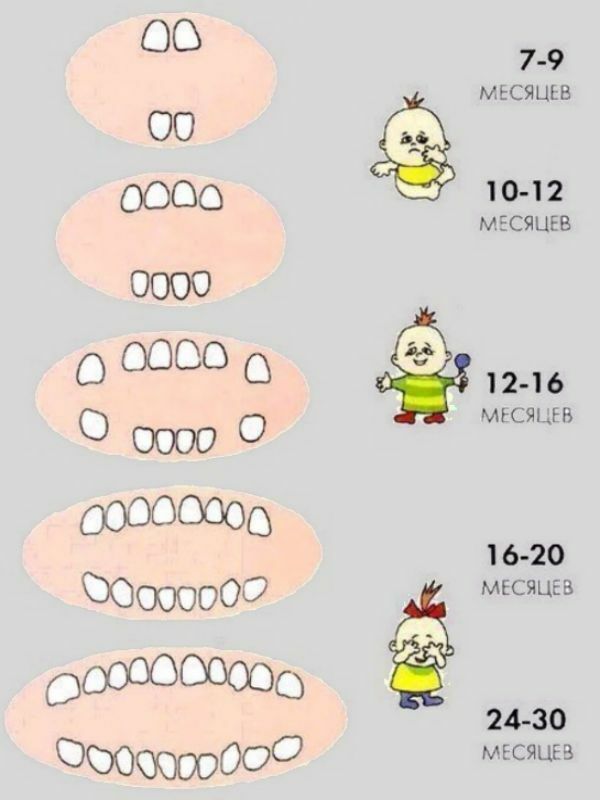
A tooth is a bony organ in the mouth of a person with nerve plexuses inside. The process of eruption, formation and strengthening of teeth begins with the earliest childhood of man. It is from this moment on that we should begin to take care of the healthy development and health of the child's teeth. To ensure that the process of development and growth of the teeth does not cause any problems, all parents need to know the minimum information about the milk and molar teeth of children from 0 to 14 years old.
- Teething teeth
- Teething permanent teeth
Teething baby teeth
Teething baby teeth begins in children from 6 months to 2 years and is about to end. By this time, a healthy child should have 20 teeth.
The appearance of the first teeth in a child is often accompanied by nasal congestion, increased drowsiness, fever, frequent crying, stomach problems, refusal of food, excessive salivation.
To help the child cope with the negative consequences of teething, you can use special medications, nipples, teethers. You can also do a little gum massage for the baby. According to the calculations of pediatricians, the sequence of teething in children up to a year is unstable and can deviate for several months. So the first teeth can appear in 3-4 months.
Paired teeth begin to erupt at about the same time. If the left chisel grows, then soon the right one will form.
When forming baby teeth, the presence of interdental spaces is normal. This indicates a properly developing bite.
Sequence of teething:
- Central incisors .Begin to erupt first. Lower in 6-10 months, upper in 7-12.
- Side cutters .The lower ones erupt at 7-16 months, the upper ones at 9-12.
- Fangs .The lower ones erupt in 16-23 months, the upper ones in 16-22 months.
- Upper molars .The lower ones erupt in 12-18 months. The top in 13-19 months.
- Second molars .The lower ones erupt in 20-31 months. The upper in 25-33 months.

It is important to know:
- It is forbidden to give a baby sweet during teething so as not to provoke the development of caries.
- It is important to distinguish the beginning of teething from an infectious disease. Therefore, if a temperature of over 38 degrees and inflammation of the mucosa is detected, the pediatrician should be consulted.
- The sequence of teething in a child of 1 year suggests that at 12 months he must form at least 1 tooth. If this did not happen, it is worth paying attention and identifying a possible problem.
Among such problems can be:
- Adentia - no rudiments of teeth.
- Rickets due to lack of calcium.
- Hypothyroidism - a violation of hormone production.
Teething permanent teeth
With 3-5 years, the final development of the roots of temporary teeth and strengthening them in the bone tissue. After this begins a gradual loosening of the milk teeth with the replacement of their permanent. The change of milk teeth to permanent teeth occurs once. Permanent teeth begin to form directly under the milk teeth. Teeth of the lower jaw often erupt faster than the maxillary.
The sequence of teething in children after 3 years suggests that the teeth erupt in a certain order. Small deviations do not cause fear, but a sharp contradiction to the natural order should be discussed with the doctor. Such violations are an anomaly and speak of undesirable processes in the human body.
The rate of formation of one group of teeth differs from the other and this is the norm.
Sequence of eruption of permanent teeth:
- Central incisors .They replace non-permanent incisors, which fall in the region of 6-8 years.
- Side cutters .Change lateral dairy cutters, which fall out in 7-8 years.
- Fangs .They replace dairy fangs, which drop out in 9-12 years.
- First premolars .The first molars are replaced, which drop out in 9-11 years.
- Second premolars .Second molars are replaced, which drop out in 10-12 years.
- Second molars .Formed when the child reaches the age of 11-13 years.
- Third molars( wisdom teeth) .Formed when the child reaches 14-16 years of age. May be completely absent. Sometimes in the jaw there is not enough room for their eruption, which causes problems.
With 3-4 years old the child should start showing the orthodontist to determine the presence or absence of bite abnormalities. The doctor may prescribe the use of trains or orthodontic plates. In the future, this will help to ease or avoid further correction of the bite( treatment in braces).
